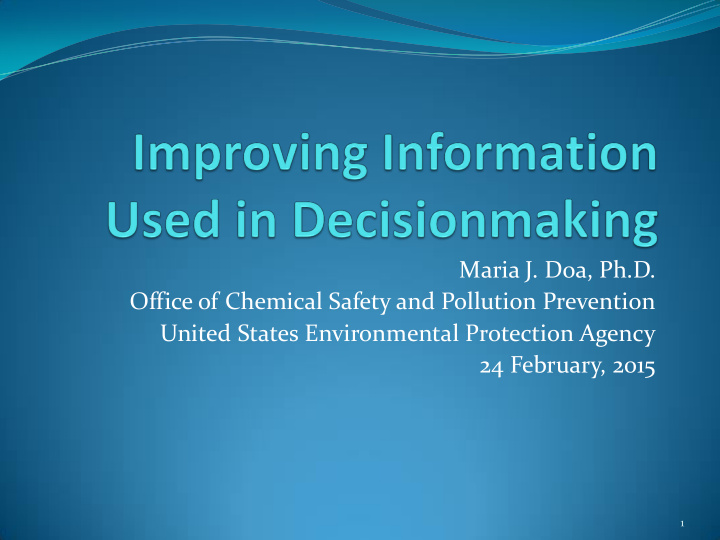



Maria J. Doa, Ph.D. Office of Chemical Safety and Pollution Prevention United States Environmental Protection Agency 24 February, 2015 1
The Need for Improved Information What is needed? Development of testing that is quicker and less expensive Why? Data on new nanoscale chemical substances reviewed under the Toxics Substances Control Act (TSCA) are often not generated until several years after commercialization Decisions are made on limited information 2
TSCA - New Chemicals TSCA section 5 requires a manufacturer (producer or importer) of a new chemical substance to submit a � premanufacture notice� �PMN� to EPA 9� days before the date of intended start of production or import of the subject substance During that 90-day review period, EPA assesses whether the manufacture, processing, distribution in commerce, use or disposal of the substance presents or may present an unreasonable risk to human health or the environment
TSCA - New Chemicals TSCA requires new chemical manufacturers to submit only studies/data in their possession or control No minimum set of toxicity or fate studies are required No test data are required to be submitted with a notification Predictive models/technical tools, data on analogs and professional judgment must be utilized by EPA to assess potential risks
TSCA – New Chemicals • Is the information available to EPA sufficient to permit a reasoned evaluation of the health and environmental effects of the substance? • In the absence of sufficient information, may the substance present an unreasonable risk of injury to health or the environment? • May require testing to provide these data
Use of Analogs Given the limited data on nanoscale materials EPA uses analogs Acceptable given the finding is that the chemical �may present an unreasonable risk� Respirable, Poorly Soluble Particulates Based on existing data Potential for respirability - particles ≤ �� µ in diameter Based on test data on 5 different poorly soluble particulates Silica, talc, titanium dioxide, lithium manganese oxide, and carbon black Human and animal data Can be used solely for effects on the lung as a result of inhalation 6
Physicochemical Characterization Characterization of nanoscale materials in toxicity studies Physicochemical characterization is critical to understanding what has been the subject of toxicity studies Poor physicochemical characterization of nanomaterials limits the usability of many studies Partially because many researchers have not been aware of the importance of characterization and the aspects of nanoscale materials that should be characterized Limits the usability of toxicity data on nanoscale analogs
Regulatory Decision If the nanoscale materials are respirable then EPA cannot make a determination that the material may not present an unreasonable risk, unless Workers wear personal protective equipment so that they will not inhale the nanoscale materials There are no releases to the environment By a certain product volumes (based on profitability), the company must conduct specified studies, usually including a 90-day inhalation study The 90-day inhalation study is almost always only provided when a certain production volume is reached which is typically years after the nanomaterial is first commercialized. 8
9
Recommend
More recommend